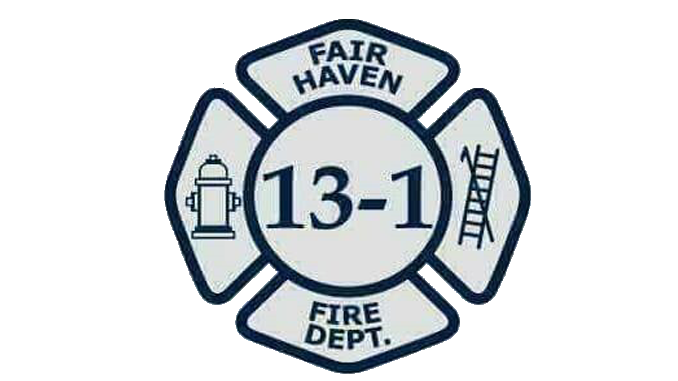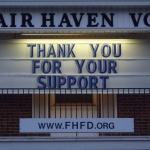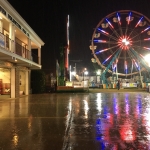Practice makes perfect
from Asbury Park Press
November 17, 2008
ATLANTIC HIGHLANDS — At 9 a.m. Sunday, a call went out to the Police Department: There was a fire aboard a crowded SeaStreak ferry.
Local police, firefighters and first aid squads and the Office of Emergency Management quickly mobilized and made their way onto the ferry parked in the harbor. The engine fire was controlled, commuters were taken off, and their conditions were checked. They were decontaminated by the Monmouth County Hazardous Materials Response Team, checked for the extent of their injuries and grouped in a holding area, while responders called for additional backup, as well as helicopter transport for two seriously injured victims.
 Though dozens of responders and emergency equipment were on site, no actual emergency was transpiring; it was a mass casualty drill to measure the teamwork and response times of police, fire and medical staff and volunteers at the local and county level during a large-scale incident.
Though dozens of responders and emergency equipment were on site, no actual emergency was transpiring; it was a mass casualty drill to measure the teamwork and response times of police, fire and medical staff and volunteers at the local and county level during a large-scale incident.
Atlantic Highlands First Aid Squad President Lou Marotta said the exercise was meant to test the Port Security EMS Planning Initiative, guidelines for responders to use when responding to large-scale incidents on the New Jersey side of the New York harbor.
The Atlantic Highlands ferry terminal is among the 27 sites determined most vulnerable by the state Office of Homeland Security and Preparedness, according to the first aid squad.
Marotta said that while he was not aware of any specific threats targeting the harbor, commuter rails and ferries were considered at-risk targets, and the exercise was a means to prepare and rehearse for mass casualties.
 Seventy-five “victims” were used for the simulation.
Seventy-five “victims” were used for the simulation.
After being led off the boat and walked through the decontaminating tents, which were equipped with showers (only two people were physically rinsed off in the chilly weather and gusty winds), victims were given disaster triage tags to hang around their necks, detailing the extent of their injuries according to a color: Green indicated minor injuries that probably do not require hospitalization, yellow indicated non-life-threatening injuries, red indicated life-threatening injuries, and black signified someone who died.
Eddie Pandolfo, 15, and Mike Lucas, 15, both Henry Hudson Regional School students from Atlantic Highlands, volunteered as victims who wore green tags.
Pandolfo said he has seen first aid calls and drills before, as his father is a member of the first aid squad, while Lucas said the procedure was new to him.
Despite a large setup of several emergency response departments, Marotta said that when a call comes in, they do not mobilize at the scene at once.
Overseeing the first responders were first aid squad Captain Jerry Pandolfo, Fire Chief Beau Marois and police Lt. Michael Lee, all of Atlantic Highlands. In a situation such as this, those three response teams are the first on the scene.
From there, reinforcements from the county and surrounding towns are called in if needed. Sunday’s drill had a dozen first aid squads and fire units from nearly all Bayshore and Middletown stations, as well as from Matawan, Rumson, Eatontown, Fair Haven and Aberdeen.
Marotta said the drill was designed to be managed at the county level, but state resources also were made available.
Those resources included the state’s EMS Task Force, State First Aid Council, State Police aviation and marine units, and the American Red Cross, in addition to the Coast Guard, Air Marshal Service, Naval Intelligence, and MONOC and NorthStar helicopters.
Summoned during the drill to transport two seriously injured victims, state EMS Task Force safety officer Pete Dworsky said the MONOC helicopter was dispatched from Robert J. Miller Airpark in Toms River, while NorthStar choppers fly from Somerset Airport in Bedminster.
Flying at speeds between 130 and 160 mph, depending on the wind, the MONOC helicopter could make it to the field in about 11 minutes, he said.
Shannon Martiak, Atlantic Highlands First Aid Squad vice president and drill coordinator, said after the drill is complete, all the response teams hold a meeting to discuss the process and follow up later in the week to make sure anything that needs to be fixed is.
“We finalize what can be improved on, in terms of what we saw and did,” he said.
Martiak said the drill ran smoothly, with only a few things that would be discussed.
“We had a real live drill on 9/11,” Borough Administrator and Office of Emergency Management Coordinator Adam Hubeny said.
More than 2,000 people were transported to and assessed at the Atlantic Highlands harbor during the 2001 terrorist attacks. Simulations such as these help keep emergency responders prepared to handle such emergencies, he said.
“It keeps us on top of our game,” he said.




